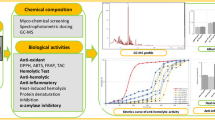Abstract
It has been found that the application of nonspecific inhibitor of NO-synthase L-NAME caused the depolarization shift of the membrane potential of premotor interneurons of defensive behavior of terrestrial snails. This effect is opposite to hyperpolarization shift of the membrane potential caused by the action of the nitric oxide donor—sodium nitroprusside.


Similar content being viewed by others
References
Steinert, J. R., Chernova, T., & Forsythe, I. D. (2010). Nitric oxide signaling in brain function, dysfunction, and dementia. The Neuroscientist, 16, 435–452.
Huang, S., Kershbaum, H. H., Engel, E., & Hermann, A. (1997). Biochemical characterization and histochemical localization of nitric oxide synthase in the nervous system of the snail, Helix pomatia. Journal of Neurochemistry, 69, 2516–2528.
Elphick, M. R., Kemenes, G., Staras, K., & O'Shea, M. (1995). Behavioral role for nitric oxide in chemosensory activation of feeding in a mollusc. The Journal of Neuroscience, 15, 7653–7664.
Kazakevich, V. B., Sidorov, A. V., & Gourine, V. N. (2000). Nitric oxide coordinates feeding and defensive behavior of Lymnaea stagnalis. Journal of Neurophysiology, 83, 116–125.
Susswein, A. J., Katzoff, A., Miller, N., & Hurwitz, I. (2004). Nitric oxide and memory. The Neuroscientist, 10(2), 153–162.
Antonov, I., Ha, T., Antonova, I., Moroz, L. L., & Hawkins, R. D. (2007). Role of nitric oxide in classical conditioning of siphon withdrawal in Aplysia. The Journal of Neuroscience, 27(41), 10993–11002. https://doi.org/10.1523/JNEUROSCI.2357-07.2007.
Balaban, P. M., Roshchin, M. V., Timoshenko, A. K., Gainutdinov, K. L., Bogodvid, T. K., Muranova, L. N., Zuzina, A. B., & Korshunova, T. A. (2014). Nitric oxide is necessary for labilization of a consolidated context memory during reconsolidation in terrestrial snails. The European Journal of Neuroscience, 40(6), 2963–2970.
Muranova, L. N., Bogodvid, T. K., Andrianov, V. V., & Gainutdinov, K. L. (2016). Effects of NO donors and inhibitors of NO synthase and guanylate cyclase on the acquisition of a conditioned defense food aversion response in edible snails. Bulletin Experimental Biology and Medicine, 160(4), 414–416.
Dyakonova, T. L., & Reutov, V. P. (1998). Effect of nitrite on the excitability of brain neurons in helix. Ross. Fiziol. Zh. imeni I. M. Sechenova (Russian), 84(11), 1264–1272.
Mothet, J. P., Fossier, P., Tauc, L., & Baux, G. (1996). Opposite actions of nitric oxide on cholinergic synapses: which pathways? Proceedings of the National Academy of Sciences of the United States of America, 93(16), 8721–8726.
Malyshev, A. Y., & Balaban, P. M. (1999). Synaptic facilitation in Helix neurons depends upon postsynaptic calcium and nitric oxide. Neuroscience Letters, 261(1-2), 65–68.
Zsombok, A., Schrofner, S., Hermann, A., & Kerschbaum, H. H. (2000). Nitric oxide increases excitability by depressing a calcium activated potassium current in snail neurons. Neuroscience Letters, 295(3), 85–88.
Patel, B. A., Arundel, M., Parker, K. H., Yeoman, M. S., & O’Hare, D. (2006). Detection of nitric oxide release from single neurons in the pond snail, Lymnaea stagnalis. Analytical Chemistry, 78(22), 7643–7648.
Bogodvid, T. K., Andrianov, V. V., Muranova, L. N., & Gainutdinov, K. L. (2016). Influence of nitric oxide donors on electrical characteristics of the premotor interneurons of terrestrial snails. BioNanoScience, 6(4), 320–321. https://doi.org/10.1007/s12668-016-0221-1.
Gainutdinova, T. K., Andrianov, V. V., Gainutdinov, K. L., Mukhamedshina, D. I., & Tagirova, R. R. (2003). Duration in electrical characteristics of command neurons after defensive conditioning in snail. Zhurnal vysshei nervnoi deiatelnosti imeni I P Pavlova (Russian), 53, 379–382.
Balaban, P. M. (2002). Cellular mechanisms of behavioral plasticity in terrestrial snail. Neuroscience and Biobehavioral Reviews, 26, 597–630.
Khodorov, B. I. (1974). The problem of excitability: electrical excitability and ionic permeability of the nerve membrane (p. 301). New York, NY: Plenum Press.
Andrianov, V.V., Bogodvid, T. Kh., Deryabina, I.B., Golovchenko, A.N., Muranova, L.N., Tagirova, R.R., Vinarskaya, A.Kh., Gainutdinov, Kh. L. (2015). Modulation of withdrawal reflex conditioning in snails by serotonin. Frontiers in Behavioral Neuroscience, 9(279), 1–12. https://doi.org/10.3389/fnbeh.2015.00279.
Korshunova, T. A., & Balaban, P. M. (2014). Nitric oxide is necessary for long-term facilitation of synaptic responses and for development of context memory in terrestrial snails. Neuroscience, 266, 127–135.
Gainutdinov, K. L., Gainutdinova, T. H., & Chekmarev, L. Y. (1996). Changes of electrical characteristics of command neurons during defensive reflex conditioning in terrestrial snail. Zhurnal vysshei nervnoi deiatelnosti imeni I. P. Pavlova (Russian), 46, 614–616.
Schrofner, S., Zsombok, A., Hermann, A., & Kerschbaum, H. H. (2004). Nitric oxide decreases a calcium-activated potassium current via activation of phosphodiesterase 2 in Helix U-cells. Brain Research, 999(1), 98–105.
Park, A-R., Lee, H.I., Semjid, D., Kim, D.K., Chun, S.W. (2014). Dual effect of exogenous nitric oxide on neuronal excitability in rat substantia gelatinosa neurons. Neural Plasticity 2014 ID 628531, doi: 10.1155/2014/628531.
Gainutdinov, K. L., Andrianov, V. V., & Gainutdinova, T. K. (2011). Changes of the neuronal membrane excitability as cellular mechanisms of learning and memory. Uspekhi Physiologicheskikh Nauk (Russian), 42, 33–52.
Author information
Authors and Affiliations
Corresponding author
Rights and permissions
About this article
Cite this article
Bogodvid, T.K., Andrianov, V.V., Muranova, L.N. et al. Influence of Nonspecific Inhibitor of NO-Synthase L-NAME on Electric Characteristics of Premotor Interneurons of Terrestrial Snails. BioNanoSci. 8, 884–887 (2018). https://doi.org/10.1007/s12668-018-0533-4
Published:
Issue Date:
DOI: https://doi.org/10.1007/s12668-018-0533-4




